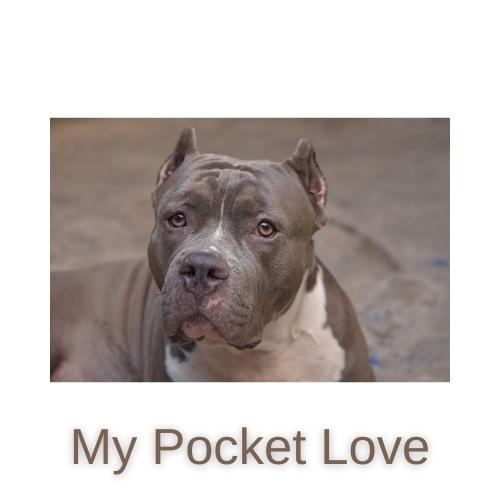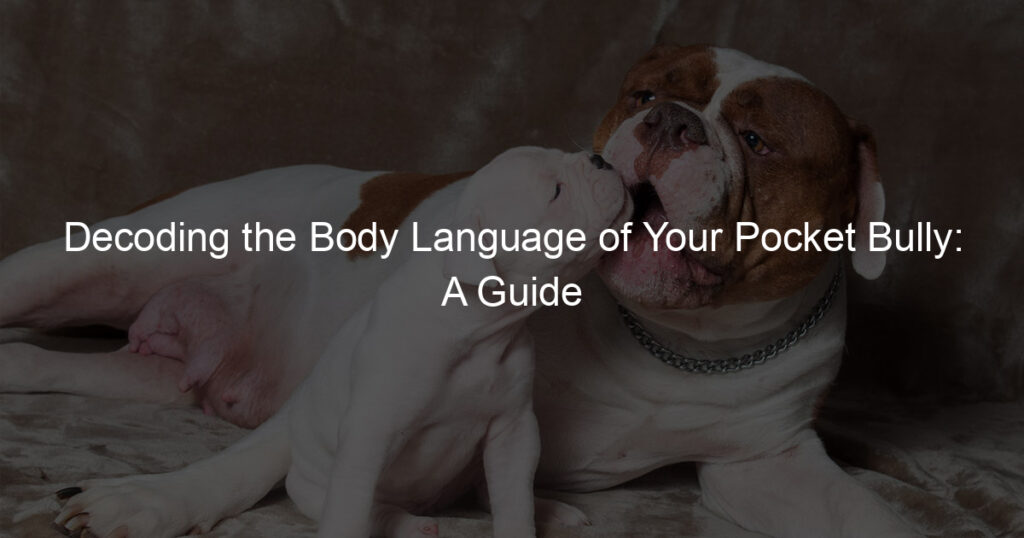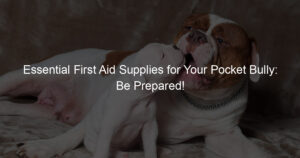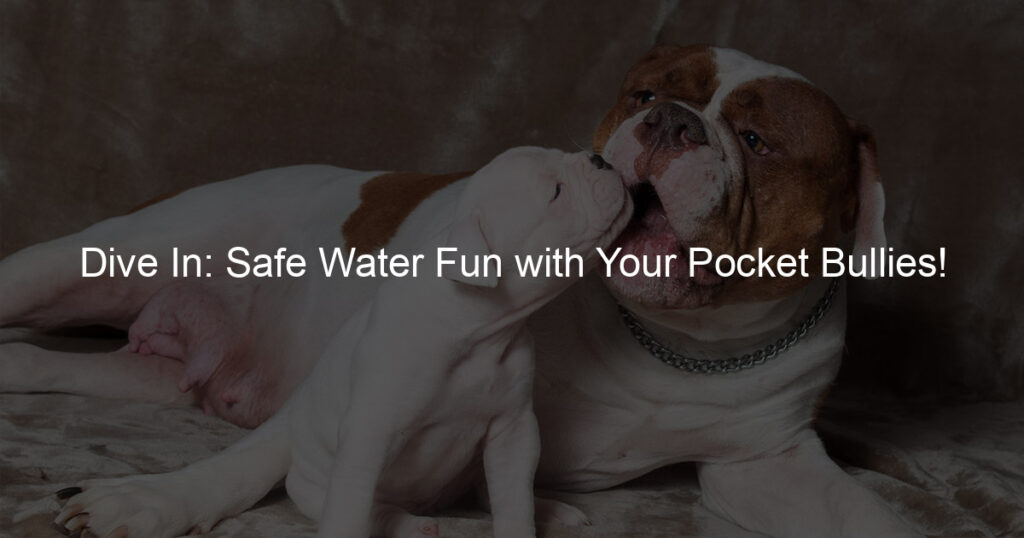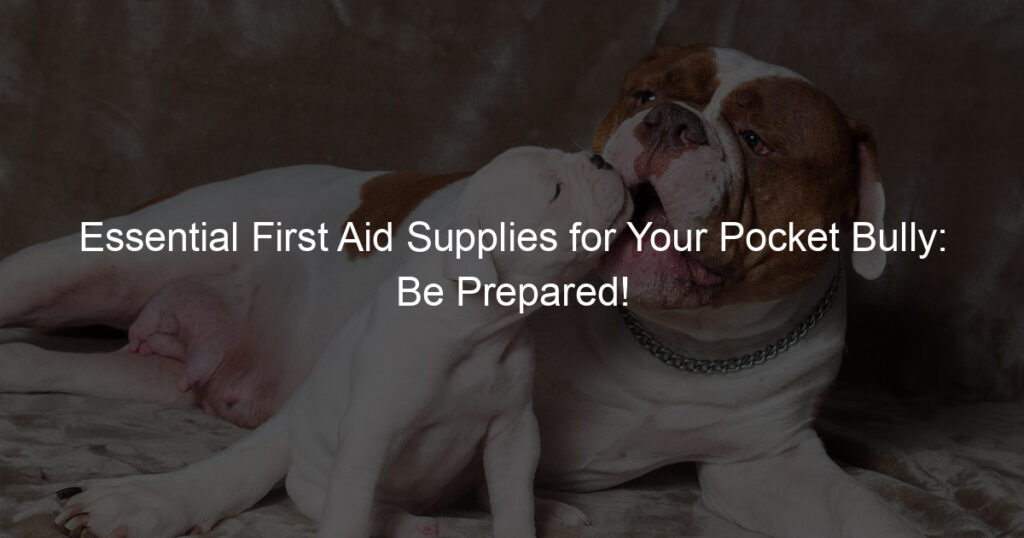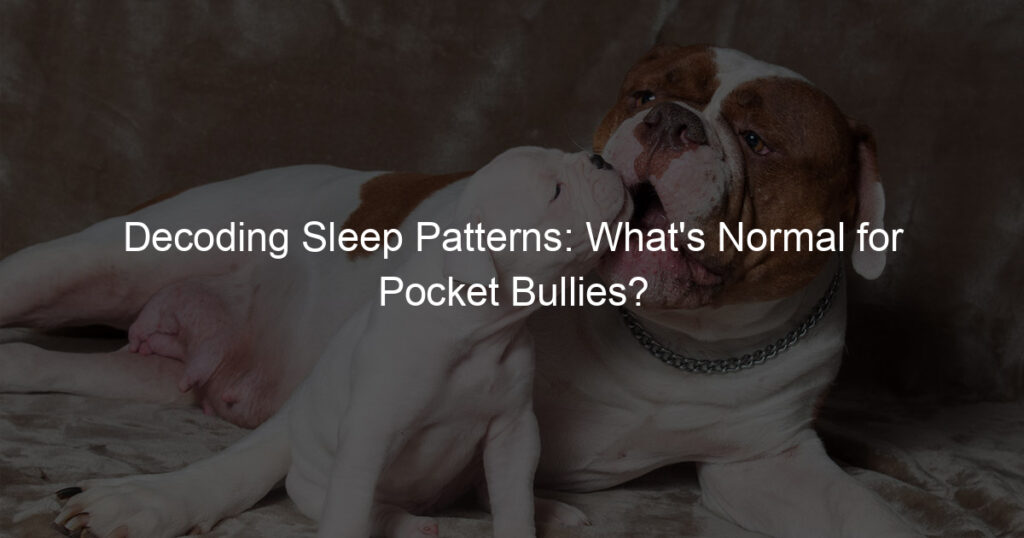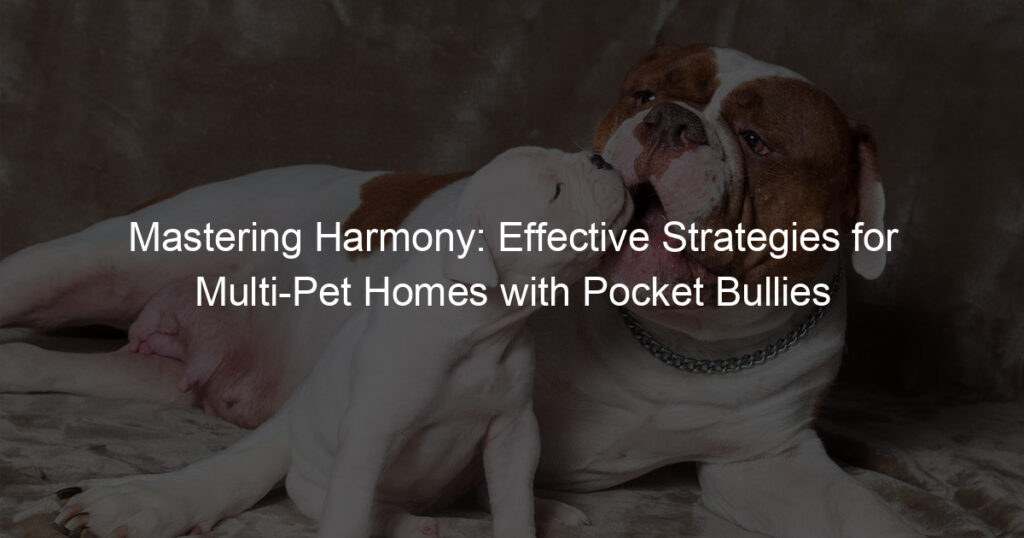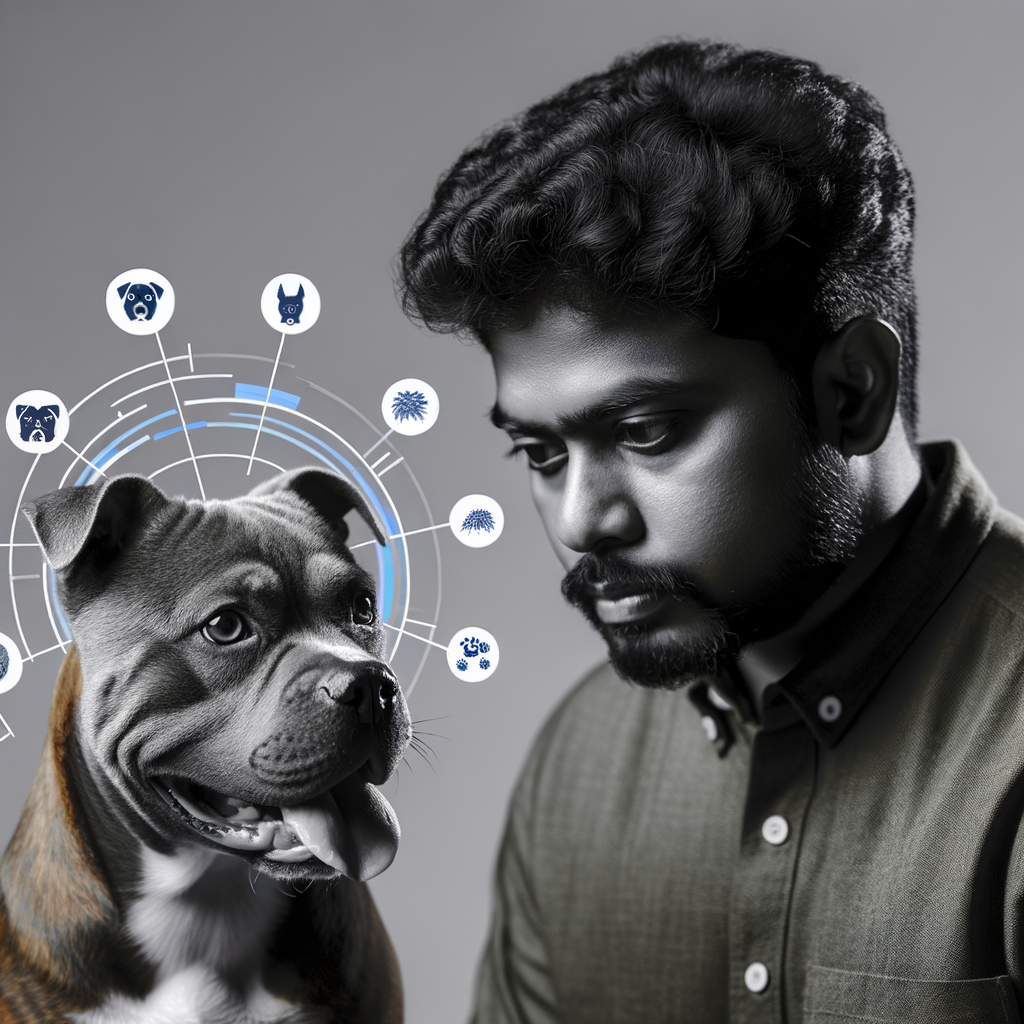
Understanding Pocket Bullies Body Language
Understanding the body language of your Pocket Bullies is crucial. It helps you to connect with your pet on a deeper level, ensuring their health and happiness. In this section, we will discuss the importance of understanding your Pocket Bullies and common body language signs they may exhibit.
- Importance of understanding your Pocket Bullies
- Common Pocket Bullies body language signs
- Tail wagging: This usually indicates happiness or excitement, but the speed and direction of the wag can also provide clues about their mood.
- Ears pinned back: This can indicate fear or submission.
- Yawning or licking lips: These can be signs of stress or anxiety.
- Rolling over: This can be a sign of submission or a request for belly rubs.
Understanding your Pocket Bullies’ body language is essential for several reasons. First, it allows you to understand their feelings and needs better, which can help prevent behavioral problems. Second, it can help you identify any health issues early on, as changes in body language can often indicate discomfort or illness. Lastly, understanding your Pocket Bullies’ body language can strengthen your bond with them, as it shows that you are attentive to their needs and emotions.
Pocket Bullies, like other dogs, use their bodies to communicate. Here are some common body language signs:
Remember, every dog is unique, and these signs can vary based on the individual dog’s personality and experiences.
In the next section, we will delve deeper into decoding Pocket Bullies behavior and interpreting dog body language.
Decoding Pocket Bullies Behavior
Understanding the behavior of Pocket Bullies is essential for a harmonious relationship with your pet. This involves learning to read their signals and interpret their body language. Let’s delve into these two aspects.
- Reading Pocket Bullies signals
Pocket Bullies, like all dogs, communicate primarily through body language. They use a variety of signals to express their feelings and intentions. Here are some common signals that your Pocket Bullies might use:
| Signal | Meaning |
|---|---|
| Tail wagging | Excitement or happiness |
| Whining or whimpering | Distress or discomfort |
| Growling | Warning or threat |
| Yawning | Stress or tiredness |
Remember, these are just general guidelines. Each dog is unique and may have its own way of communicating. The key is to pay close attention and learn your dog’s specific signals.
- Interpreting dog body language
Interpreting dog body language goes beyond just reading signals. It involves understanding the context in which these signals are used. For example, a wagging tail usually means a dog is happy. However, if the tail is stiff and the wagging is fast, it could indicate aggression.
Here are some tips to help you interpret your dog’s body language:
- Look at the whole body, not just one part. The position of the tail, ears, and body can all provide clues about what your dog is feeling.
- Consider the situation. A dog that is growling while playing may just be excited, not aggressive.
- Watch for changes in behavior. A sudden change could indicate that something is wrong.
Understanding your Pocket Bullies’ behavior can strengthen your bond and make your interactions more enjoyable. So, take the time to learn their signals and body language. It’s a language worth learning!
Pocket Bullies Behavior
Understanding the behavior of Pocket Bullies is essential for any owner. Their behavior can be categorized into two main types: aggressive and submissive. Let’s dive deeper into these behaviors to better understand our furry friends.
- Understanding aggressive behavior
- Understanding submissive behavior
Aggressive behavior in Pocket Bullies can manifest in various ways. They may growl, bark loudly, or even attempt to bite. This behavior often stems from fear, territorial instincts, or a lack of socialization. It’s important to remember that aggression is not always a sign of a ‘bad dog’. Instead, it’s a communication tool for them to express discomfort or fear.
Submissive behavior, on the other hand, is a way for Pocket Bullies to show respect and acknowledgment of another’s dominance. Signs of submission may include lowering the body or tail, avoiding direct eye contact, or rolling over to expose the belly. This behavior is normal and is a part of their natural communication system.
Understanding these behaviors can help you better communicate with your Pocket Bully, ensuring a happier and healthier relationship. Remember, every dog is unique and may not display these behaviors in the same way. Always observe and learn from your pet’s individual behaviors.
Understanding Your Pocket Bullies
One of the most fascinating aspects of owning a Pocket Bully is learning to understand their unique body language. Dogs, including Pocket Bullies, use a variety of non-verbal cues to communicate their feelings, intentions, and needs. By learning to decode these signals, you can build a stronger bond with your pet and ensure their well-being.
- Decoding Pocket Bullies non-verbal communication
- Understanding the importance of tail wagging
Pocket Bullies, like all dogs, use their bodies to express a wide range of emotions. They rely on their ears, eyes, mouth, tail, and overall body posture to communicate. For example, a relaxed Pocket Bully may have a loose, wiggly body and a wagging tail. On the other hand, a scared or anxious dog may tuck its tail under its body and avoid eye contact.
It’s important to note that some signals can have multiple meanings. For instance, a dog showing its teeth could be a sign of aggression, but it could also be a submissive grin or even a sign of discomfort. Therefore, it’s crucial to consider the overall context and the dog’s entire body language.
Many people believe that a wagging tail always means a happy dog. However, this is not always the case. The speed, direction, and position of the tail can indicate a variety of emotions.
A high, stiff wagging tail can indicate excitement or aggression, while a low, slow wag might mean that the dog is feeling insecure or submissive. A tail that wags more to the right is often associated with positive feelings, while a tail that wags more to the left may indicate negative emotions.
By understanding the nuances of tail wagging, you can better understand your Pocket Bully’s emotions and respond appropriately.
In conclusion, understanding your Pocket Bully’s non-verbal communication is key to building a strong, healthy relationship with your pet. It allows you to respond to their needs effectively, prevent potential issues, and ensure their happiness and well-being.
Interpreting Dog Body Language
Understanding a dog’s body language is crucial for effective communication with our furry friends. Dogs use their bodies to express their feelings and intentions. This guide will help you interpret their signals accurately.
- Understanding the meaning of different ear positions
- Decoding the meaning of different facial expressions
Dogs use their ears to communicate a lot. Here’s what different ear positions might mean:
| Ear Position | Description |
|---|---|
| Upright | This usually indicates that the dog is alert and attentive to the surroundings. |
| Flat against the head | A dog might flatten its ears when it’s scared or wants to show submission. |
| Relaxed | When a dog’s ears are in their natural position, it usually means the dog is calm and comfortable. |
Just like humans, dogs also use facial expressions to communicate. Here are some common ones:
| Facial Expression | Description |
|---|---|
| Bared teeth | This can be a sign of aggression. However, some dogs might also do this when they’re playing. |
| Relaxed mouth | When a dog’s mouth is slightly open and relaxed, it’s a good sign that the dog is comfortable and happy. |
| Panting | Dogs pant when they’re hot, excited, or stressed. The context can help you figure out what they’re feeling. |
Remember, every dog is unique and might not always follow these general guidelines. The best way to understand your dog’s body language is to spend time with them and observe their behavior in different situations.
Pocket Bullies Communication
Communication is a vital part of any relationship, including the one you share with your Pocket Bully. One of the main ways these dogs communicate is through barking. Let’s delve into the importance of barking and how to decode different barking sounds.
- Understanding the Importance of Barking
- Decoding the Meaning of Different Barking Sounds
Barking is a primary form of communication for dogs. It’s their way of expressing emotions and alerting their owners to potential threats. For Pocket Bullies, barking can indicate a variety of things, from excitement and playfulness to fear or aggression. Understanding why your Pocket Bully barks is crucial to building a strong bond and ensuring their needs are met.
Did you know that a study by the American Veterinary Society of Animal Behavior found that dogs bark for a variety of reasons, including attention-seeking, warning, fear, boredom, and responding to other dogs? This highlights the importance of paying attention to your Pocket Bully’s barking.
Not all barks are created equal. Different barks can mean different things. Here’s a quick guide to help you understand what your Pocket Bully might be trying to tell you:
| Type of Bark | Possible Meaning |
|---|---|
| Continuous, rapid barking | Your dog might be alerting you to a potential threat or expressing fear. |
| Single sharp bark | This could be a surprise or a sudden, unexpected sound. |
| Stutter-bark | Your Pocket Bully might be inviting you to play. |
Remember, every dog is unique. The key to understanding your Pocket Bully’s barks is to pay attention to the circumstances and their body language when they bark. This will give you valuable clues about what they’re trying to communicate.
Dog Body Language Interpretation
Understanding your dog’s body language is crucial for building a strong and healthy relationship with your pet. Dogs communicate primarily through body language, and being able to interpret these signals can help you understand your dog’s needs and emotions better. In this section, we will focus on two key aspects of dog body language: body posture and eye movements.
- Understanding the Meaning of Body Posture
- Decoding the Meaning of Different Eye Movements
Body posture is a significant part of a dog’s communication. A relaxed dog will generally have a loose, relaxed posture, while a scared or nervous dog may crouch or make itself appear smaller. On the other hand, an aggressive or dominant dog may try to make itself appear larger by standing tall and puffing out its chest. Remember, each dog is unique, and these are general guidelines. Always consider the context and your dog’s overall behavior.
Eye movements can also provide insight into a dog’s emotions and intentions. For instance, when a dog avoids direct eye contact, it may be showing submission or fear. Conversely, a dog making direct, prolonged eye contact could be displaying dominance or aggression. Rapid eye movement, especially when accompanied by other signs of agitation, could indicate that a dog is stressed or anxious.
Understanding these aspects of dog body language can help you respond appropriately to your dog’s needs, improving your bond and ensuring your dog’s well-being. Remember, patience and observation are key in accurately interpreting your dog’s body language.
Pocket Bullies Body Language Signs
Understanding the body language of your Pocket Bully can be a fascinating and insightful experience. It can help you communicate better with your pet and understand their needs and emotions. In this section, we will explore two key aspects of Pocket Bullies body language: tail positions and paw movements.
- Understanding the meaning of different tail positions
Just like humans, Pocket Bullies use their body to express their emotions. One of the most expressive parts of their body is their tail. Let’s decode what different tail positions mean:
| Tail Position | Meaning |
|---|---|
| Wagging | This usually indicates happiness or excitement. However, the speed and direction of the wag can also indicate different emotions. |
| Tucked under | This is a sign of fear or submission. Your dog might be feeling threatened or uncomfortable. |
| Held high | This can be a sign of alertness or dominance. Your dog is likely feeling confident and in control. |
- Decoding the meaning of different paw movements
Another important part of a Pocket Bully’s body language is their paw movements. These can be subtle, but once you know what to look for, they can provide valuable insights into your dog’s state of mind. Here are some common paw movements and their meanings:
| Paw Movement | Meaning |
|---|---|
| Paw lift | This can indicate uncertainty or curiosity. Your dog might be unsure about something in their environment. |
| Scratching | While this can sometimes indicate a physical issue like fleas or allergies, it can also be a sign of stress or anxiety. |
| Pawing at you | This is often a sign of affection or a request for attention. Your dog might want to play or be petted. |
Remember, every dog is unique and these are general interpretations. Always consider the overall body language and behavior of your Pocket Bully to understand their emotions better.
Decoding Pocket Bullies Behavior
Understanding the behavior of Pocket Bullies is crucial for their proper care and training. This section will focus on two common behaviors: sniffing and licking. By the end of this section, you will be able to interpret what your Pocket Bully is trying to communicate through these actions.
- Understanding the Meaning of Different Sniffing Behaviors
- Decoding the Meaning of Different Licking Behaviors
Sniffing is a natural behavior for all dogs, including Pocket Bullies. It’s their way of exploring the world around them. However, the intensity and frequency of sniffing can indicate different things.
| Sniffing Behavior | Meaning |
|---|---|
| Intense Sniffing | Your Pocket Bully might have found something interesting or is trying to gather more information about a particular scent. |
| Occasional Sniffing | This is a casual behavior indicating that your Pocket Bully is relaxed and comfortable in its environment. |
Remember, sniffing is a vital part of a dog’s life. It’s not only a way for them to explore, but it also provides mental stimulation.
Licking is another common behavior in Pocket Bullies. It can be a sign of affection, but it can also indicate other things depending on the context.
| Licking Behavior | Meaning |
|---|---|
| Licking Humans | This is usually a sign of affection. Your Pocket Bully is showing that it trusts and loves you. |
| Licking Themselves | If your Pocket Bully is licking a specific area on their body excessively, it might be a sign of discomfort or pain in that area. |
While licking is generally a harmless behavior, excessive licking can sometimes indicate health issues. If you notice any unusual licking behavior, it’s best to consult with a vet.
Understanding your Pocket Bully’s behavior is key to building a strong and healthy relationship with them. Always pay attention to their actions and try to understand what they are trying to communicate. Remember, every dog is unique and might display behaviors differently.
Pocket Bullies Non-Verbal Communication
Just like humans, Pocket Bullies also use non-verbal communication to express their feelings and intentions. Two significant aspects of this non-verbal communication are yawning and stretching. Let’s delve deeper into understanding these behaviors.
- Understanding the meaning of different yawn types
Yawning is not just a sign of tiredness in Pocket Bullies. It can also be a calming signal, a way for your dog to diffuse stress. Here are some common yawn types and their meanings:
| Yawn Type | Meaning |
|---|---|
| Long, slow yawn | This is a sign of tiredness. Your Pocket Bully is ready for a nap. |
| Quick, short yawn | This could be a sign of stress or discomfort. Your dog might be feeling anxious. |
| Yawn with a high-pitched sound | This is a sign of excitement. Your dog might be eager to play. |
- Decoding the meaning of different stretch types
Stretching is another form of non-verbal communication in Pocket Bullies. It can signify various things, from waking up from a nap to showing submission. Here are some common stretch types and their meanings:
| Stretch Type | Meaning |
|---|---|
| Full body stretch | This is a sign that your Pocket Bully is waking up or has been lying down for a while and is now ready to get moving. |
| Half body stretch (front) | This could be a sign of submission. Your dog is showing respect to another dog or human. |
| Half body stretch (back) | This is a sign of excitement. Your dog might be ready to play or is eager for a walk. |
Understanding these non-verbal cues can greatly enhance your relationship with your Pocket Bully, allowing you to better meet their needs and respond to their feelings. Remember, every dog is unique, so these interpretations might not always be accurate. It’s always best to observe your dog in different situations to understand their specific communication style.
